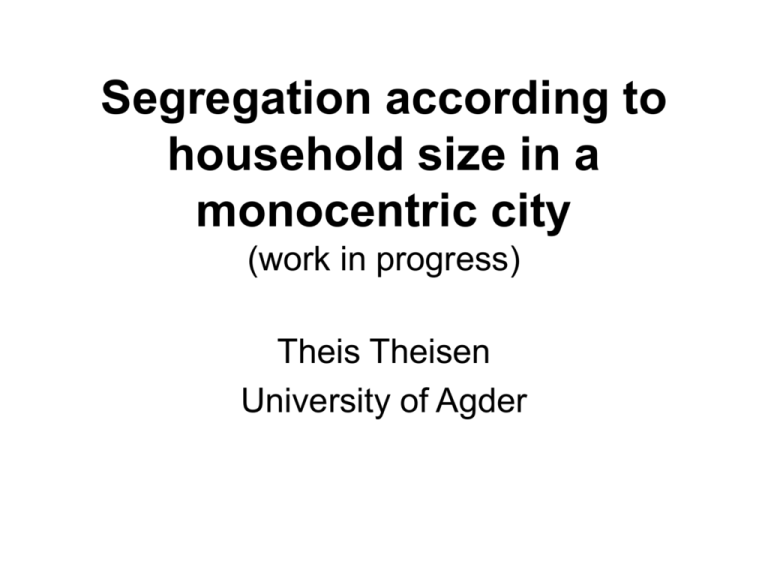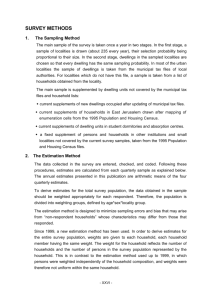The relationship between household size an the structure of cities
advertisement

Segregation according to household size in a monocentric city (work in progress) Theis Theisen University of Agder Introduction Increase in single-person households: • 15 % in Norway 1950 • 38 % in Norway 2001 • In Oslo 2001: More than 50 % single person households What are the consequences? - for households living in a city - for the structure of cities Issues of interest: • Will the two household types be segregated? • The utility level of single-person and multiperson households • Extension of the city • multiperson households to live in the city centre warranted? The baseline model • Monocentric city • Individuals have identical preferences • Household preferences depend on size (n) u uc, q; n • Income for an individual in full-time job exogenous (y) • Household labour force paticipation, , exogenous • Costs of commuting t nx • Price per sqm. floor space depends on location Budget constraint for household located at distance x from city centre: yn c pxq t nx The baseline household model Max u yn px q t n x, q; n q u qn yn t nx px q, q; n u yn t nx px q, q; n n c p x v yn t nx,1, px , n v n p t n x q (First order condition) (All households of type n enjoy the same utility) (Rent of land declining function of distance from city centre) Rent gradients for households of size 1 and 2 p 1 t 2 2 x q 1 1 1 2 Rent gradient single person household Rent gradient two person household Transport cost ratio Land consumption ratio Proposition 1. If 1 , single-person households have at ~ x a steeper rent gradient than two-person households. When this condition is fulfilled, single person households ~ will occupy the dwellings closer to the city centre than x ,while two-person households will live further from the ~ city centre than x. Assumption 1: Single-crossing preferences MRS 2 MRS 1 Numeraire good B A Land Result 1: If: • Income in the two person household equal to income in one person household • Costs of transportation the same in the two households (for the same distance) • Single-crossing preferences (Assumption 1) will the single-person household have steepest rent gradient, and live close to city centre. Describes well the situation in the middle of the last century Two problems with Result 1: • Not so relevant today, with high female labour force participation • Aggregate income in a city with a given population will depend on how individuals group themselves into households We want to neutralize the last effect by assuming: • Assumption 2: The labour force participation rate is 1 in all households We also assume: • Assumption 3: Costs of transportation t 1 t 2 0.5, 1 Optimum for both household types Numeraire good Optimum for single-person household Optimum for two-person household B A C D Land Spatial segregation of households according to size Rent Single-person households Two-person households Agriculture ~ x Distance from city centre Oslo Munich Conclusions A simple theoretical model with: - economies of scale in household consumption - unequal household incomes according to household size - unequal costs of transportation can explain why: - single-person households will live centrally - two-person households will live less central The theoretical model obtains empirical support






